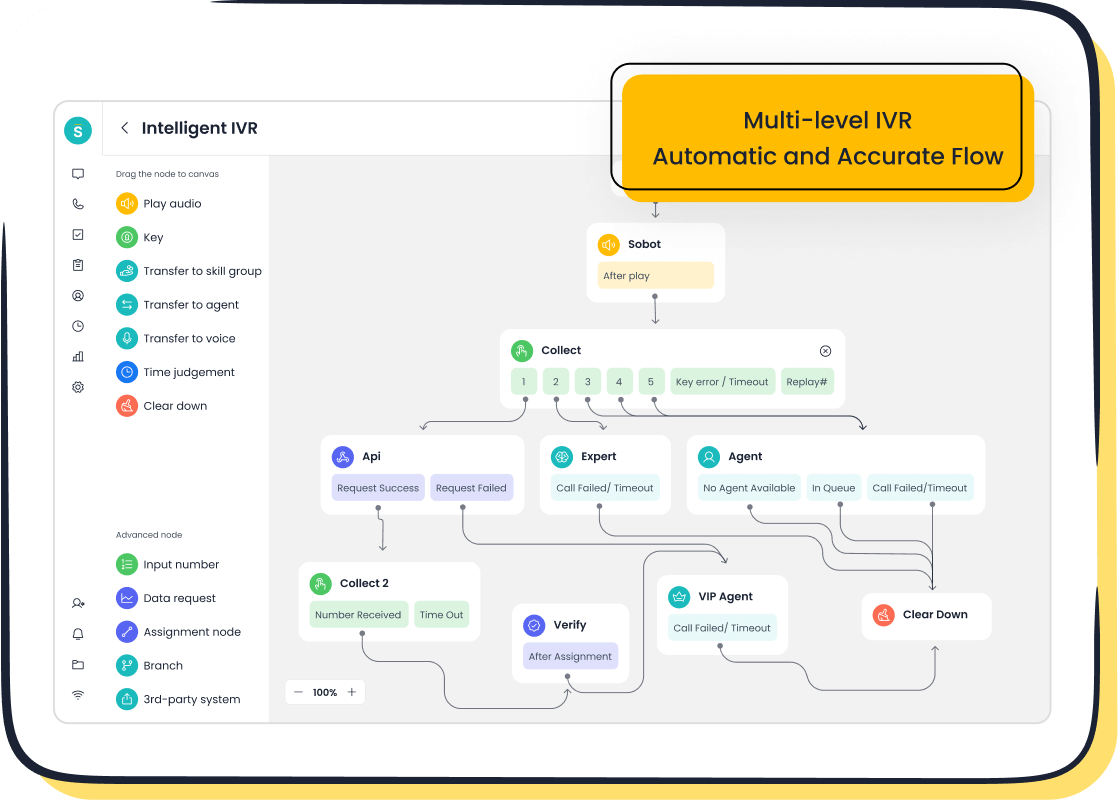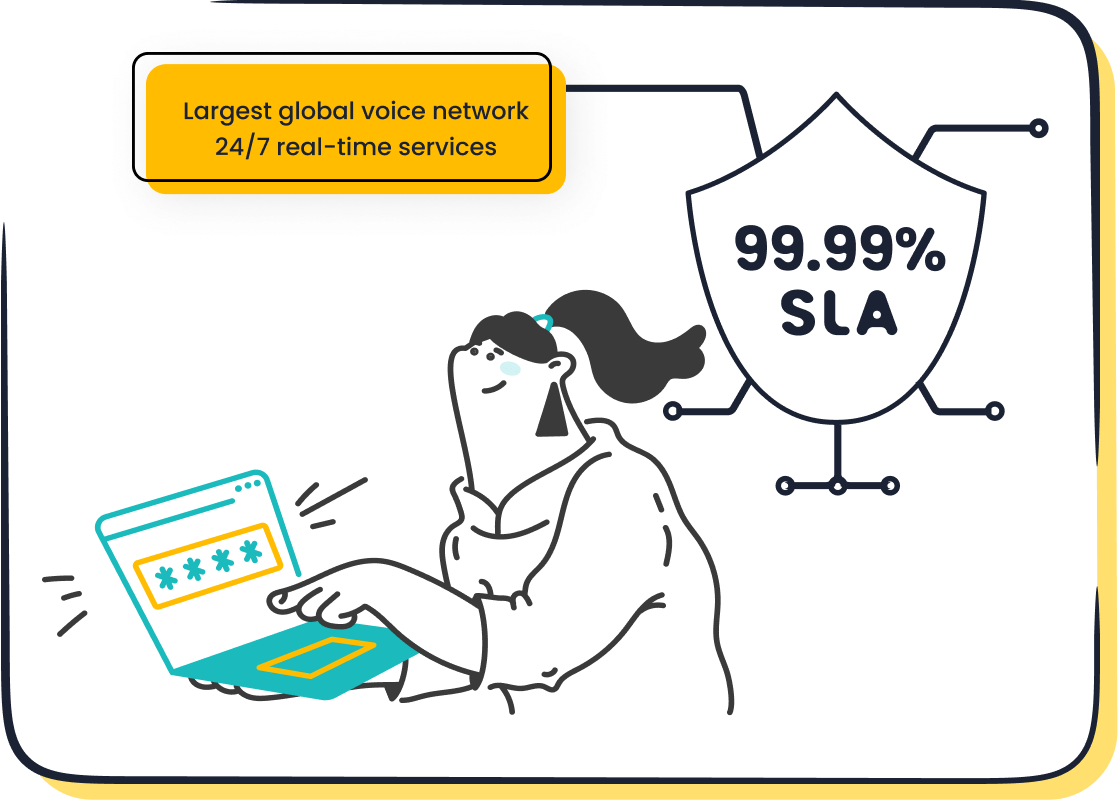Network Layer Speech Recognition Trends in 2025

Network layer speech recognition (NLSR) is revolutionizing customer service by enabling seamless, real-time communication. In 2025, its adoption in customer service industries has surged to 81%, reflecting its growing importance. Businesses now rely on advanced speech recognition technology to enhance efficiency and meet customer expectations. AI and machine learning have further refined this technology, improving accuracy and enabling recognition of diverse accents.

Sobot’s Voice/Call Center exemplifies these advancements. Its AI-powered voicebots and smart call routing streamline customer interactions, ensuring faster resolutions. These innovations highlight how NLSR is transforming customer service into a more responsive and personalized experience.
The Role of the Network Layer in Speech Recognition
What is Network Layer Speech Recognition (NLSR)?
Definition and Core Functions
Network layer speech recognition (NLSR) refers to the integration of speech recognition technology directly into the network infrastructure. This approach enables real-time processing of voice data, ensuring faster and more accurate responses. Unlike traditional systems, NLSR operates at the network level, reducing latency and improving efficiency. Its core functions include voice-to-text conversion, intent recognition, and seamless integration with communication platforms. By leveraging advanced AI, NLSR ensures high accuracy, even in complex scenarios.
Importance in Real-Time Communication
In customer service, real-time communication is critical. NLSR plays a pivotal role by processing voice data instantly, allowing agents to respond without delays. For example, when a customer calls a support center, NLSR can transcribe and analyze their query in real time. This capability not only enhances the customer experience but also boosts agent productivity. Businesses that adopt NLSR can handle higher call volumes while maintaining quality service.
Applications in Customer Service
Enhancing Call Center Operations
NLSR transforms call center operations by automating routine tasks and improving efficiency. It reduces average call handling time (CHT), enabling agents to focus on complex issues. The table below highlights measurable impacts:
| Metric | Impact Description | Example Calculation |
|---|---|---|
| Reduced Average Call Handling Time (CHT) | Saves time during calls, allowing for reallocation of resources. | Cutting 2 minutes per call across 1,000 daily calls saves 2,000 agent hours monthly. |
| Operational Cost Savings | Reduces dependency on human agents through automation, leading to financial savings. | Automating 30% of calls in a 100,000-call/month center saves $150,000 annually. |
| Improved Self-Service Completion Rates | Increases customer empowerment and satisfaction by enabling issue resolution without agents. | Increasing self-service resolution rates by 15% leads to fewer agent-assisted calls. |
Supporting Multichannel Customer Interactions

Modern customers interact with businesses through multiple channels, including phone, chat, and email. NLSR ensures consistent service across all platforms by unifying voice data with other communication channels. For instance, Sobot's Voice/Call Center integrates NLSR to provide a unified workspace for agents. This feature allows agents to access customer data and communication history in one place, ensuring seamless interactions.
Sobot's Contribution to NLSR
Integration with Sobot Voice/Call Center

Sobot has seamlessly integrated NLSR into its Voice/Call Center solution. This integration enables features like AI-powered voicebots, smart call routing, and real-time transcription. These tools empower your business to handle customer inquiries more efficiently. With a 99.99% system uptime and global network support, Sobot ensures reliable and scalable solutions for businesses of all sizes.
Benefits for Customer Contact Solutions
By adopting Sobot's NLSR-enabled solutions, you can achieve significant improvements in customer service. These include reduced operational costs, enhanced agent productivity, and higher customer satisfaction rates. For example, Sobot's multilingual support ensures that businesses can cater to diverse audiences, breaking language barriers and improving accessibility.
Key Trends in Network Layer Speech Recognition in 2025
Real-Time Processing and Low Latency
Advances in 5G and Beyond
The rollout of 5G and emerging network technologies has revolutionized speech recognition technology. These advancements enable faster data transmission, reducing latency to near-zero levels. Real-time transcription and translation now bridge language gaps, empowering individuals with hearing impairments and those facing language barriers. Businesses benefit from increased productivity during meetings, as note-taking and discussions become effortless. For example, real-time voice AI facilitates faster interactions, making immediacy in responses an expectation rather than a luxury. These trends are driving innovation across industries, ensuring that network layer speech recognition (NLSR) remains at the forefront of customer service advancements.
Impact on Customer Service Efficiency
Low latency ensures that customer service agents can respond instantly to inquiries. Real-time transcription allows agents to focus on solving problems rather than taking notes. This efficiency improves customer satisfaction and reduces average handling time. Companies using NLSR, like Sobot’s Voice/Call Center, experience streamlined operations through AI-powered tools. These tools enhance productivity and ensure seamless multilingual digital communication, making customer interactions more effective.
Edge Computing and IoT Integration
Localized Processing for Faster Responses
Edge computing processes data closer to the source, reducing reliance on centralized servers. This localized approach ensures faster responses, especially in time-sensitive scenarios. For customer service, edge computing enables real-time transcription and analysis, allowing agents to address customer needs promptly. AI-powered voicebots, integrated with IoT devices, further enhance operational efficiency by automating routine tasks and improving response times.
Applications in Smart Customer Support Devices
IoT integration transforms customer support by enabling voice-enabled applications. These applications allow users to manage IoT devices through natural language, making interactions intuitive. For example, smart call routing directs calls to the right agents based on customer needs, improving service quality. Companies like Weee! achieved a 96% customer satisfaction score by leveraging Sobot’s solutions, showcasing the effectiveness of speech recognition in enhancing customer support.
Cloud and Hybrid Cloud Solutions
Scalability for Global Contact Centers
Cloud solutions offer unmatched scalability for global contact centers. Businesses can deploy these solutions within days, ensuring faster implementation compared to traditional setups. Hybrid models provide greater security by storing sensitive data securely while utilizing public cloud resources. Cloud-based speech recognition technology ensures consistent service delivery across regions, enabling businesses to meet the demands of a global audience.
Multilingual AI Support for Diverse Audiences
Cloud solutions support multilingual digital communication by offering real-time translation and language detection. These features allow agents to handle calls in multiple languages, increasing productivity and reducing training costs. Businesses can expand into new markets without hiring native speakers, making global expansion more accessible. Around-the-clock language support ensures that customers receive assistance anytime, enhancing satisfaction and loyalty.
Innovations and Use Cases in 2025
AI-Driven Multilingual Speech Recognition
Supporting Global Customer Bases
AI-driven multilingual speech recognition is transforming how businesses interact with diverse audiences. Modern systems now offer seamless multilingual support, allowing companies to cater to global customer bases effectively. For instance, Sobot’s Voice/Call Center provides multilingual templates, enabling businesses like Weee! to overcome language barriers and serve customers in their preferred languages. Improved contextual understanding further enhances accuracy, especially in specialized fields like healthcare or finance. These advancements empower businesses to expand globally while maintaining high-quality customer service.
Real-Time Language Adaptation
Real-time language adaptation ensures immediate assistance for customers, eliminating delays caused by language differences. This innovation improves response times, which is crucial in today’s fast-paced market. Multilingual chatbots, powered by AI, provide 24/7 support, enhancing customer engagement and satisfaction. For example, Sobot’s solutions use real-time transcription and translation tools to streamline communication, making interactions more efficient and inclusive for diverse audiences.
Voice Recognition for Security and Privacy
Voice Biometrics in Customer Authentication
Voice recognition software now incorporates advanced biometrics for secure customer authentication. AI and machine learning algorithms analyze vocal biomarkers to detect fraud attempts and improve recognition accuracy. Real-time processing ensures instantaneous authentication, enhancing both security and user experience. For example, deep learning algorithms can identify spoofing attempts, making voice biometrics a reliable tool for industries like banking and healthcare.

Encrypted Data Transmission in Speech Recognition
Automatic speech recognition systems prioritize data security through encrypted transmission. This ensures that sensitive customer information remains protected during interactions. Sobot’s Voice/Call Center, for instance, uses encrypted data transfer to safeguard customer communications, providing businesses with a secure and reliable platform for handling inquiries.
Sobot's Voice/Call Center Use Cases
Case Study: Weee! and Multilingual Support

Weee!, America’s largest online Asian supermarket, leveraged Sobot’s Voice/Call Center to address challenges like language barriers and inflexible IVR systems. By implementing multilingual templates and intelligent call routing, Weee! achieved a 20% increase in agent efficiency and a 50% reduction in resolution time. The customer satisfaction score soared to 96%, showcasing the transformative applications of speech recognition in customer service.
Enhancing Customer Satisfaction with AI-Powered Tools
Sobot’s AI-powered voicebots and smart call routing tools have revolutionized customer interactions. These tools handle routine inquiries, reducing wait times and improving satisfaction rates. Over 95% of customers report satisfaction with Sobot’s services, and 85% of problems are resolved through AI solutions. These results highlight how speech recognition technologies can enhance operational efficiency and customer experiences.
Challenges and Solutions in Network Layer Speech Recognition
Overcoming Latency and Connectivity Issues
Optimizing Network Infrastructure
To address latency challenges, you can optimize network infrastructure using several strategies. Collecting diverse datasets and preprocessing audio data ensures high-quality inputs for speech recognition systems. Feature extraction techniques, such as MFCCs, convert audio signals into formats suitable for AI models. Selecting advanced architectures like RNNs or CNNs enhances performance, while optimization techniques like gradient clipping improve training efficiency. Regularization methods prevent overfitting, ensuring robust models even with smaller datasets. These practices not only reduce latency but also improve the accuracy of speech recognition in healthcare, where real-time responses are critical.
Leveraging Edge and Cloud Synergy
Combining edge computing with cloud solutions creates a synergy that minimizes connectivity issues. Edge computing processes data locally, reducing delays, while cloud systems handle large-scale data storage and analysis. For example, Sobot’s Voice/Call Center leverages this synergy to provide real-time transcription and multilingual support. This approach ensures seamless communication, even in regions with inconsistent network connectivity. By integrating edge and cloud technologies, you can achieve faster response times and improved service reliability.
Addressing Data Privacy Concerns
End-to-End Encryption and Compliance
Data privacy remains a top concern in speech recognition systems. Risks include unauthorized access to cloud-stored voice data and misuse of biometric information like voiceprints. End-to-end encryption ensures that sensitive data remains secure during transmission. Compliance with privacy laws, such as GDPR and HIPAA, further protects user information. In healthcare, where patient confidentiality is paramount, these measures are essential for maintaining trust and legal compliance.
Federated Learning for Secure AI Models
Federated learning enhances data security by training AI models without transferring sensitive data to central servers. Techniques like homomorphic encryption allow computations on encrypted data, ensuring privacy. Secure Multi-Party Computation (SMPC) enables collaboration among institutions without exposing sensitive information. Differential privacy protects individual data points while allowing meaningful insights. These innovations make federated learning a valuable tool for speech recognition in healthcare, where data security is non-negotiable.
Scaling for Growing Demand
Dynamic Resource Allocation in Cloud Systems
Cloud systems offer dynamic resource allocation to meet the growing demand for speech recognition services. By scaling resources based on usage patterns, you can ensure consistent performance during peak times. For instance, Sobot’s cloud-based solutions provide scalability for global contact centers, enabling businesses to handle high call volumes efficiently. This flexibility supports the expanding market size of speech recognition in healthcare, where demand continues to rise.
AI-Driven Network Optimization for Contact Centers
AI-driven optimization enhances network performance by analyzing traffic patterns and predicting resource needs. Techniques like data augmentation and transfer learning improve model robustness and accuracy. End-to-end models simplify workflows by directly converting audio to text, while attention mechanisms focus on relevant audio parts for better transcription. These advancements enable contact centers to scale operations effectively, ensuring high-quality service for a growing customer base.
Future Outlook for Network Layer Speech Recognition
Predictions for 2030 and Beyond
Integration with Next-Gen Networks (6G)
By 2030, 6G networks will redefine how you experience speech recognition. These networks promise speeds up to 100 times faster than 5G, enabling instantaneous data processing. With 6G, natural language processing (NLP) systems will achieve unprecedented accuracy, even in noisy environments. This advancement will allow you to interact with AI systems in real time, without delays or interruptions. For businesses, 6G will support massive-scale customer interactions, ensuring seamless communication across global contact centers. Sobot’s Voice/Call Center, with its robust infrastructure, will likely integrate 6G capabilities to enhance its AI-powered tools, offering you faster and more reliable customer service.
Expansion of AI-Driven Speech Interfaces
AI-driven speech interfaces will evolve to provide human-like interactions. These systems will understand your needs, recall past conversations, and offer intuitive solutions. Unlike current chatbots, future interfaces will hold fluid, natural conversations, making them indistinguishable from human voices. For example, you might interact with digital humans capable of guiding you through complex processes or answering detailed questions. This transformation will elevate customer satisfaction, as AI systems become more empathetic and responsive. Businesses using Sobot’s solutions will benefit from these advancements, delivering personalized and efficient service to their customers.
Transforming Customer Service with NLSR
Fully Automated Contact Centers
The future of customer service lies in fully automated contact centers. By leveraging NLP and AI, these centers will handle routine inquiries without human intervention. You will experience faster resolutions, as AI systems process your requests instantly. Sobot’s AI-powered voicebots already demonstrate this potential, automating tasks and reducing wait times. By 2030, these technologies will become the norm, enabling businesses to operate more efficiently while maintaining high customer satisfaction.
Personalized Customer Experiences at Scale
NLP advancements will enable businesses to deliver personalized experiences on a large scale. AI systems will analyze your preferences and tailor interactions to meet your specific needs. For instance, Sobot’s multilingual support already allows businesses to communicate with diverse audiences. In the future, these capabilities will expand, offering you highly customized solutions in real time. This personalization will strengthen customer loyalty and set new standards for service excellence.
Network layer speech recognition (NLSR) has redefined how businesses interact with customers in 2025. Its ability to process voice data in real time has made customer service faster and more efficient. Key trends like multilingual support, real-time transcription, and IoT integration have empowered businesses to connect with global audiences seamlessly. Assistants now handle diverse accents and dialects with AI-driven accuracy, ensuring every customer feels understood.
Innovations such as emotion detection and context-aware transcription have further enhanced customer experiences. Tools like Sobot’s Voice/Call Center exemplify these advancements, offering intelligent routing and multilingual templates. These features have helped companies achieve higher satisfaction scores and operational efficiency.
As NLSR continues to evolve, its potential to transform customer service and beyond remains limitless. From empowering assistants to creating personalized experiences, this technology is shaping a future where communication knows no boundaries.
FAQ
What is the current size of the speech and voice recognition market?
The speech and voice recognition market has grown significantly, reaching $27.16 billion in 2025. This growth reflects the increasing adoption of speech technology in industries like customer service, healthcare, and retail. Businesses now rely on voice recognition to enhance efficiency and improve customer experiences. Source.
How does voice recognition improve customer service?
Voice recognition enables real-time transcription, intent detection, and multilingual support. These features reduce call handling time and improve agent productivity. For example, Sobot’s Voice/Call Center uses AI-powered tools to streamline operations, ensuring faster resolutions and higher customer satisfaction rates.
What are translation applications using voice recognition?
Translation applications using voice recognition convert spoken language into another language in real time. These tools help businesses communicate with global audiences. For instance, multilingual AI in Sobot’s solutions allows seamless communication across diverse languages, breaking barriers and improving accessibility.
Why is the growth of speech technology important for businesses?
The growth of speech technology drives innovation in customer service. It enables businesses to adopt voice user interfaces, voice assistance, and real-time transcription. These advancements improve customer interactions and operational efficiency. Companies like Sobot leverage this growth to offer scalable and intelligent solutions.
How does Sobot ensure secure voice recognition?
Sobot prioritizes security with encrypted data transmission and compliance with privacy laws. Its Voice/Call Center uses advanced AI to protect sensitive customer information. This ensures businesses can rely on Sobot’s solutions for secure and efficient communication.
See Also
Best 10 Speech Analytics Solutions for Call Centers 2024
Leading Automated Voice Calling Applications Evaluated for 2024
Best VoIP Software Options Available in 2024
Best 10 Customer Feedback Software Solutions for 2024
Understanding the Functionality of IVR Voice Recognition Software
